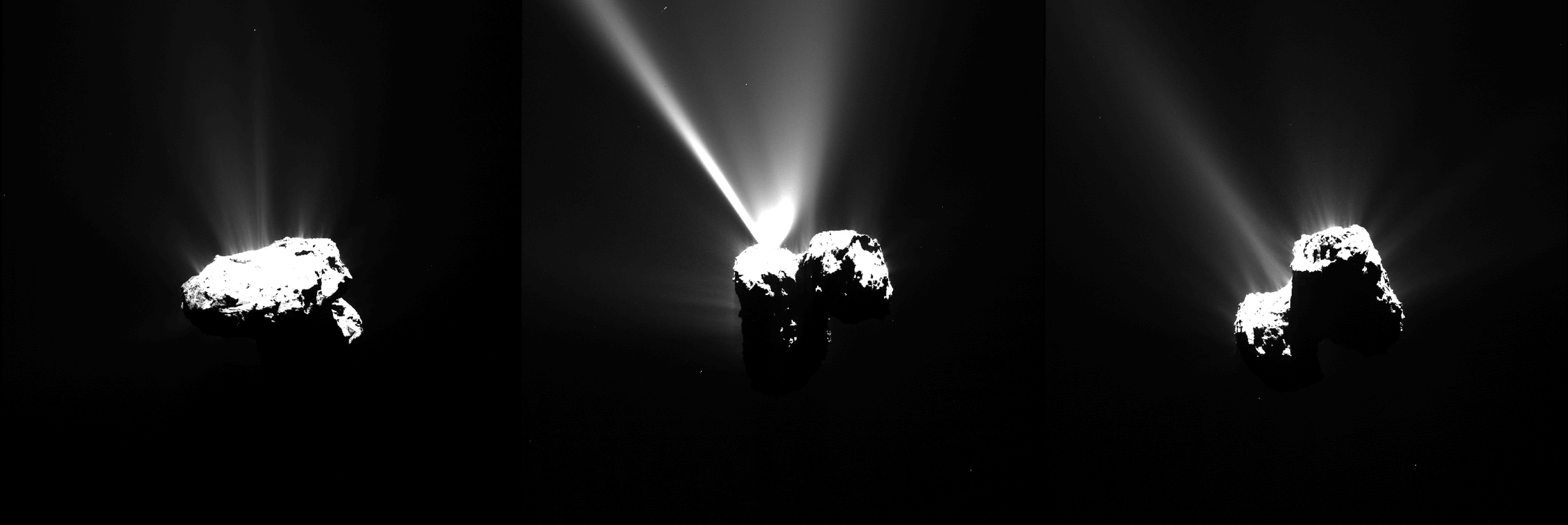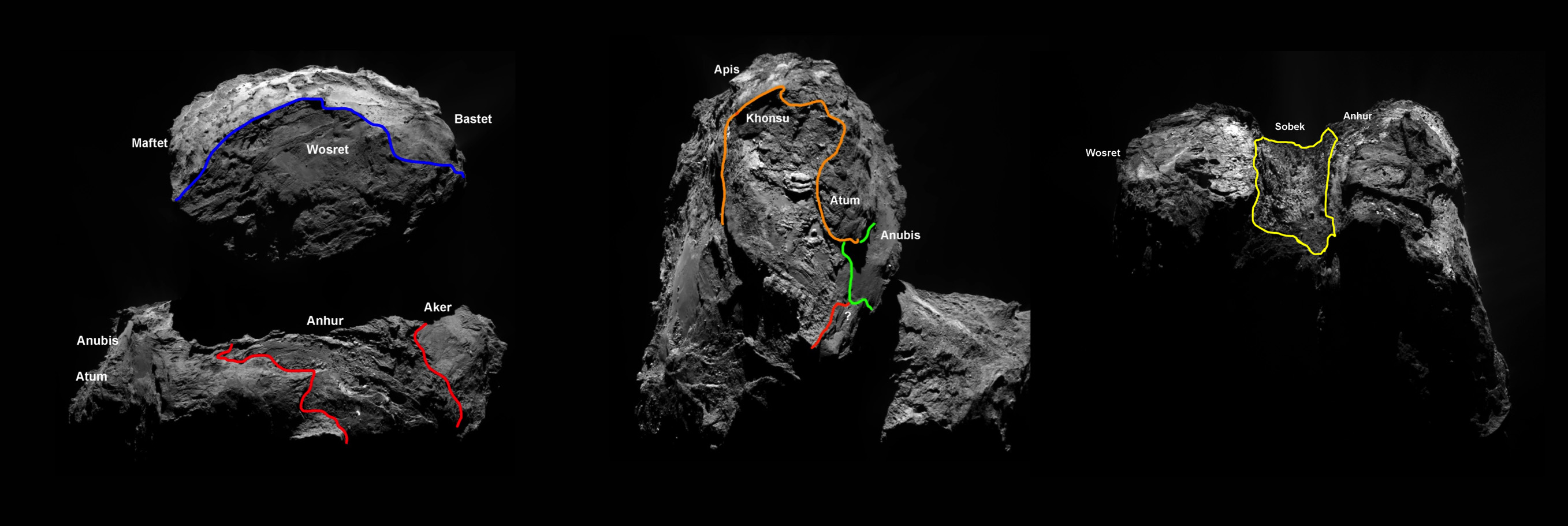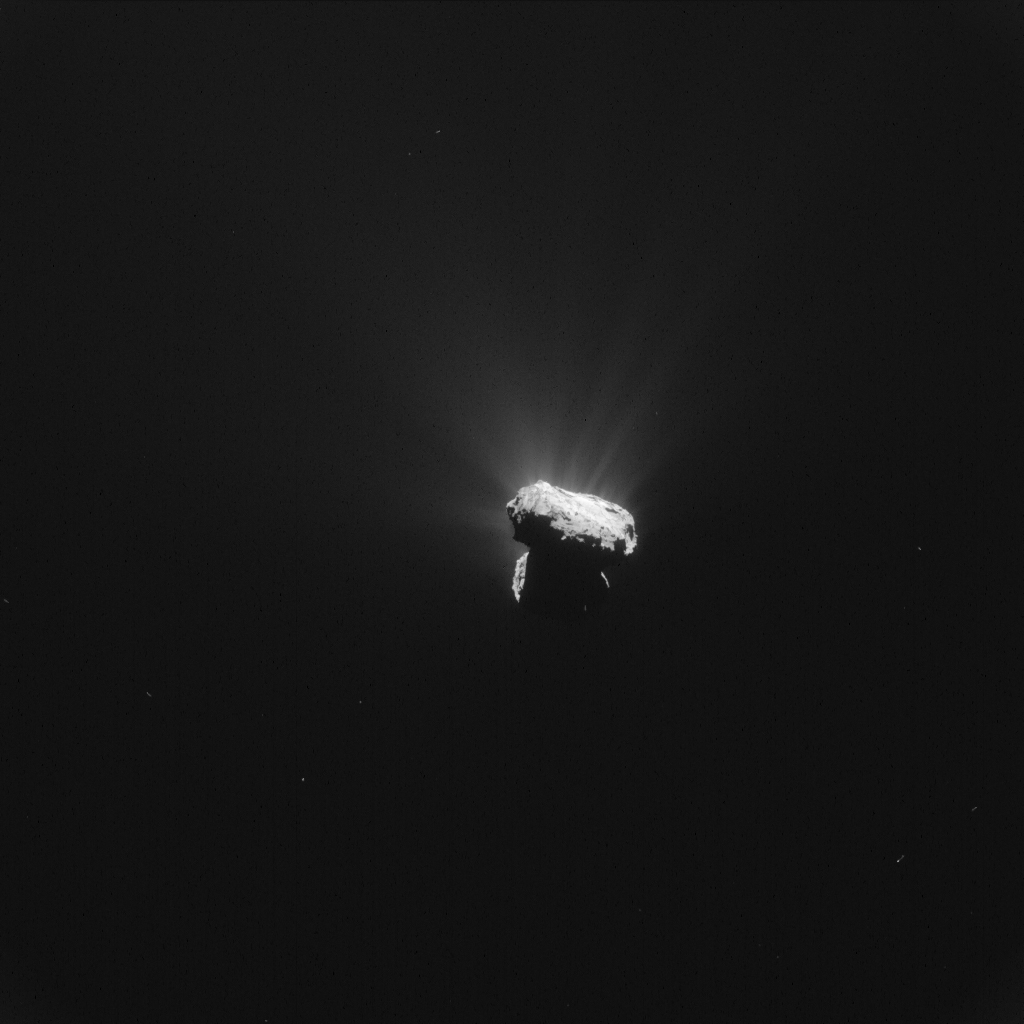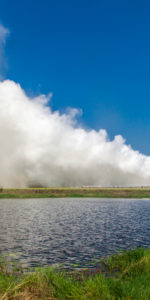
Just over a year after it reached Comet 67P/Churyumov–Gerasimenko, the European Space Agency’s (ESA) Rosetta spacecraft passed another milestone early Thursday, Aug. 13, when it became the first orbiting spacecraft to observe a comet at perihelion, its closest point to the Sun. ESA announced that the exact moment of perihelion occurred at 02:03 GMT when Comet 67P passed within 186 million kilometers of our closest star. Recent images show the comet bathed in bright light, emanating ghostly gas jets, providing the most thrilling cometary “show” since the Giotto spacecraft flew through Comet Halley’s coma in 1986.
This achievement comes nine months after Rosetta deployed a lander, Philae, successfully to Comet 67P’s surface, and one year following the spacecraft’s arrival at its cometary target. At that time, a previous AmericaSpace article discussed Rosetta’s decade-long trip, which was originally meant to reach another comet destination.
This author wrote on Aug. 6, 2014, the day Rosetta “met” Comet 67P: “Today’s rendezvous comes following a journey of 10 years, which saw Rosetta take a series of three gravity-assist flybys of Earth and one of Mars. Rosetta was originally intended to launch in January 2003, and was slated to rendezvous with comet 46P/Wirtanen in 2011. However, during that time an Ariane 5 launch failure grounded the fleet of rockets, and the launch was pushed back—which meant Rosetta would not be able to meet the previously targeted comet in time. At long last, Rosetta was launched on March 2, 2004, from the Guiana Space Centre in Kourou, French Guiana. Following the flybys of two planets (and two asteroids), it went into a lengthy (31-month-long) hibernation period. In January, Rosetta was famously ‘woken up’ and was found to be in excellent health, despite its long rest.”
In November last year, Rosetta’s Philae lander completed a portion of its science package following not one but three landings, and successfully transmitted data to Earth prior to hibernating for seven months. In June, Philae was reawakened as Comet 67P approached perihelion, and was warmed. The German Aerospace Center DLR, which controls the lander, has been trying to reestablish contact with Philae since its last transmission in July. It is hoped that Philae, as it is further exposed to solar energy, will recommence scientific operations.

As Comet 67P has become “activated,” warmed up by the Sun, it has begun to spew more water vapor and dust; a dramatic image recently released by ESA shows the comet “firing” one of its jets. According to ESA, the comet is shedding 300 kg of water vapor every second, with its nucleus shedding 1,000 kg of dust a second. Because of this impact danger, Rosetta has been moved back even further from 67P. A few weeks ago, the spacecraft was moved back to approximately 170 km from the comet; now, Rosetta is stationed a distant 325 to 340 km away. Sylvain Lodiot, ESA’s spacecraft operations manager, explained this tactic.
“In recent days, we have been forced to move even further away from the comet. We’re currently at a distance of between 325 km and 340 km this week, in a region where Rosetta’s star trackers can operate without being confused by excessive dust levels – without them working properly, Rosetta can’t position itself in space,” Lodiot underscored. Activity is expected to remain high over the next several weeks, allowing Rosetta to make further observations of a comet at its “prime.” Nicolas Altobelli, acting Rosetta project scientist, emphasized, “Activity will remain high like this for many weeks, and we’re certainly looking forward to seeing how many more jets and outburst events we catch in the act, as we have already witnessed in the last few weeks.”
In addition to observing a comet in bright sunlight with jets emanating from its dusty surface, Rosetta has also photographed Comet 67’s previously darkened southern regions. ESA revealed, “[Scientists] have now identified four new geological regions on the southern hemisphere, which includes parts of both comet lobes, bringing the total number of regions to 23. The names of the new regions follow the naming convention of Egyptian gods and goddesses adopted for the comet: Anhur, Khonsu, Sobek and Wosret.”
While Rosetta will continue to observe Comet 67P as it basks in the sunlight, as activity subsides the spacecraft will move in close again. Altobelli added, “We aim to go back in much closer again after the activity subsides and make a survey of how the comet has changed. We also continue to hope that Philae will be able to resume its scientific operations on the surface and give us a detailed look at changes which may be occurring immediately surrounding its landing site.” While controllers back on Earth wait for further “word” from Philae, Rosetta will continue surprising amateur astronomers, researchers, scientists, and space enthusiasts for another year, as it was recently announced the spacecraft’s scientific mission will be extended through Sept. 2016.

Please check back with AmericaSpace for more updates about the Rosetta mission.
Want to keep up-to-date with all things space? Be sure to “Like” AmericaSpace on Facebook and follow us on Twitter: @AmericaSpace
Missions » Rosetta »




2 Comments
2 Pings & Trackbacks
Pingback:Rosetta Spacecraft Observes ‘Dramatic and Rapid’ Changes on Surface of Comet 67P « AmericaSpace
Pingback:Rosetta Scientists Answer Question of How ‘Rubber Duck’ Comet 67P Got Its Shape « AmericaSpace